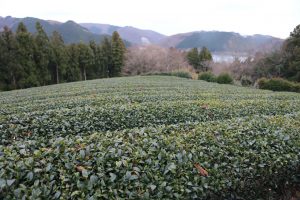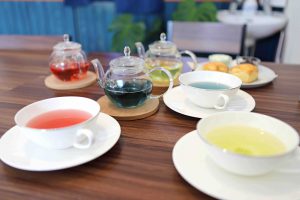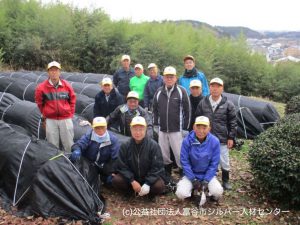MENU
MENU
Tea production area: Mono Town and Tomiya City
Brand name of tea: Mono tea and Tomiya tea
Types of tea: Sencha (medium steamed green tea) and flavored tea
History of Mono tea
It is said that the lord of Sendai Domain, Date Masamune, recommended tea production during the Edo period to promote the local industry. It was the beginning of tea industry in Miyagi Prefecture.
The tea industry was abolished but was revived some decades ago. Now (as of 2019) only one tea farmer is cultivating and making tea for commercial use in Mono Town, Ishinomaki City.

Mono tea (sencha)
Mono tea
The difference in temperature is not huge, and the climate is relatively warm throughout the year in Mono Town compared to other Tohoku regions. There are tea fields on the slopes of mountains, and the Kitakami River, which is the largest in the Tohoku region, flows by the foot of the mountain.
River fog generated from the Kitakami River blocks direct sunlight to the tea fields, and as a result it makes tasty tea with umami.

Tea fields in Mono Town (December 2019)
TEAVER TEAFACTORY
A tea maker “TEAVER TEAFACTORY” in Onagawa Town makes varieties of original blended tea such as flavored tea with Mono tea. You can drink their tea and taste sweets in their tearoom located in Onagawa Town.

MONO SENCHA、MONO BLUE and MONO ROUGE
at TEAVER TEAFACTORY (December 2019)
Revival Project of Tomiya Tea
Tomiya City is in the center of Miyagi Prefecture. Tomiya City prospered as a post town as Tomiya-juku and as a tea production area during the Edo period. However, the tea industry was abolished around 1970.
In commemoration of the 400th anniversary of the opening of Tomiya-juku, the Revival Project of Tomiya tea was started in 2019. Tomiya City Silver Jinzai center has taken the lead in regenerating the tea fields of native variety which remained in Tomiya City. The members of the center planted 1,000 nursery stock. They made sencha using a hoiro by hand in 2021.
The project plans to increase 10,000 tea plants over 5 years using by planting 2,000 cuttings each year.

The members of Tomiya City Silver Jinzai Center and
tea fields covered with materials of protection against cold (December. 2020)
Photo provided by 公益社団法人富谷市シルバー人材センター
https://webc.sjc.ne.jp/tomiya-sjc/index
*Umami is the fifth taste after sweetness, sourness, saltiness and bitterness. Umami is the intensely savory taste imparted by glutamates that occur naturally in many foods such as meat, fish, and vegetables.
Reference: Cambridge Dictionary https://dictionary.cambridge.org/
*Hoiro is a dryer for tea leaves using a heat source for making tea by hand-rolling. Steamed tea leaves are rolled by hand on the hoiro
Hoiro looks like a dining table, and a Japanese paper is pasted on the top surface. A heat source is placed inside of hoiro, and it heats up on the surface. Previously the heat source was charcoal fire, but now gas is used.
Related article on the site:
Tea related facility:
TEAVER TEAFACTORY https://www.teaver.jp
Yuru-Chara (mascot character) related tea:
Ceramic and pottery art: Tsusumi ware
Reference:
松下智 (平成3年) 日本名茶紀行 (初版) 雄山閣出版
TEAVER TEAFACTORY (ティーベル・ティーファクトリー) http://www.teaver.jp
富谷市
観光 富谷しんまち
https://www.tomiya-city.miyagi.jp
https://shinmachi-tomiya.com
広報とみや TOMIYA 7
https://www.tomiya-city.miyagi.jp/uploads/pdf/13047.pdf
公益社団法人 富谷市シルバー人材センター
*When visiting the shops and facilities introduced in this article, please check the business hours on their website, etc. before visiting.
*The information provided on this site may be updated. If you find any information in this article that is incorrect, new, or incomplete, please contact CHAMART.
*The site does not describe all “Teas of Japan” or all “Teas of the World”. Additionally, each article expresses the writer’s personal experience and feelings.
#monotea #tomiyatea #TEAVERTEAFACTORY #teatrip #greentea #tealover #enjoytea #japanesetea